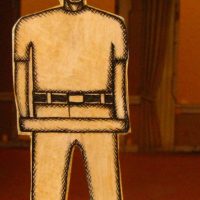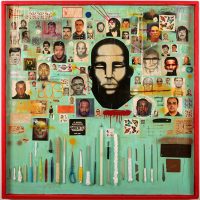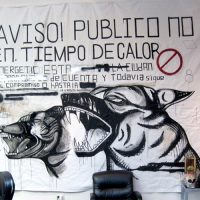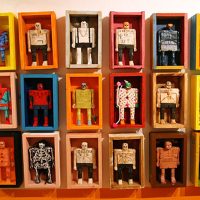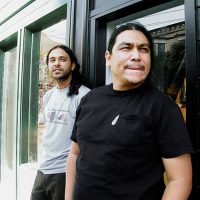
By Monica Morones
They are considered to be two of the best artists of their genre. Carlos Ramirez and Armando Lerma are the Date Farmers. With shows in major cities in the U.S., features in countless magazines, an image for the Obama Campaign, two shows at the pristine Ace Gallery Los Angeles, The Wynwood Walls in Miami, and more recently, a revitalization project that they organized bringing together artists from around the world called “Coachella Walls” in the downtown city of Coachella, this collaborative duo shines a bright light on the Coachella Valley.
MM: How did you two start making art together?
DF: We began working together around 1998. The art scene then was very minimal among the local communities especially the minority ones. There have always been galleries, which have always tended to the higher financial brackets in the desert and of a much safer subject matter, but both of us coming from working class families and working on such an unorthodox style, both working on fine art which was a battle in itself even among our own families at times. It was comforting and reinforcing for us doing such similar work, so we easily gravitated towards each other. Rather than a personal aesthetic we realized a shared aesthetic and that is what we began to build upon and developed the style that is recognized today.
MM: What is the process when you two collaborate? Organic or planned?
DF: We can easily describe our process as a more organic one in the fact that we allow certain issues whether social, political, or personal to sometimes- not all the time dictate the direction of the intended message or direction of the work, usually leaning more toward the truth seeking side. The truth is pretty organic.
MM: What do you think is the most difficult about being an artist?
DF: There is a saying that “If you love what you do, you will never work a day in your life.” This is true in so many cases, but if we had to describe the difficult, it wouldn’t be being an artist. We’re sure it’s safe to say it would be navigating in the art world. So many seem to make a great living in the art business minus the artist in most cases. It seems the artist’s integrity is the one always at stake. Try asking a mechanic for free work or for free publicity (laughing).
MM: Has all your artistic success changed you at all?
DF: From day one we have always kept our same work ethics and discipline, although our surroundings may have changed a bit. Building and prepping materials are still the same and are not going to build themselves, so that would have to be a no.
MM: The Coachella Walls Project brought some serious attention to the city of Coachella with international muralists as well as the Date Farmers, painting beautiful murals with the theme “The Anonymous Farm Worker.” How important was it as Coachella Valley natives to show that this city was more than just a name for a festival?
DF: As natives to this awesome desert and growing up in and around working class families, seeing first-hand the adversities that so many families here face on a daily basis, it was very important and vital for them and also for the young working artist and the creative force living in the valley. To bring artists such as El mac from Los Angeles, Andrew Hem from Cambodia, Nunca from Brazil, only to name a few, that have seen and can relate to the same struggles in other parts of the world, and to “draw” a line in the (so to say) sand, bringing attention to the stark contrast in “Coachella” that plays to a different tune .
MM: You just recently had your second show at the Ace Gallery Los Angeles, which in the art world is a big deal for an artist. Do you feel people treat you differently now?
DF: Being blessed and being represented and working with Ace gallery Los Angeles and it being such a well-established gallery, working with the likes of Andy Warhol to Ed Ruch, it would be a lie to say it hasn’t changed people’s perception of us. It has definitely sent a certain message in and around the art world and community internationally, but for us it’s only one of many destinations in our creative journey.
MM: It’s an artist’s dream to be on the cover of Juxtapos Magazine and the Date Farmers were featured on the cover in October 2006 and have been featured in many magazines since then. What point in your career did you feel the most validation of being a respected talented artist?
DF: Being in Juxtapos and other magazines such as Time magazine was definitely a little surreal for us, and was an awesome forum and vessel for the hard work and message we had already been doing years before. If we had to call on the most important validation it would have to be, when a total stranger can relate to us in another country or city. In one instance when a person sitting in a prison cell tells you they understood and felt what we were doing with heart felt meaning, that to us was the true validation.
MM: What do you think about social media in the art world today?
DF: The world has always and will always evolve and social media has definitely changed the art game. Its far reaches are infinite and endless making things readily available; in a sense an equalizer of sorts. That can be a great thing, but can also be a bad thing. Before the internet you had to rely on your own imagination rather than Google. It all depends on you, some people love it and some people don’t, but blaming the internet in a sense is like blaming your telephone for calling someone and starting a problem. It can be a great tool.
MM: What do you think of the art scene in the Coachella valley?
DF: We have seen the art scene in the Coachella Valley go from almost barren to becoming an awesome movement that is constantly evolving and ever changing, giving so many, young and old alike, a visual voice and avenue to express what was almost non-existent and limited to a class in high school or someone’s bedroom. Now there is tremendous amount of talent that is coming out of the desert, can’t wait to see what the future holds.
MM: What was a pivotal moment in your career where you knew your life as artists had changed?
DF: There are a few moments that signaled a change was happening for us, but the most pivotal would have to be in 2008 when we got a call from Obama’s campaign people saying he wanted us to do one of his campaign images. He definitely brought a “change.”
MM: What upcoming projects do you have lined up?
DF: We have a few things we are looking into at the moment but nothing that’s in ink just yet. So for now we are working on art and planning on some local art and music events in April, so keep an eye out.
MM: What advice can you give to local up and coming artists?
DF: If you only put 10% into what you are doing, expect 10% feedback. Take that leap and give it 100%. The rest will fall in place.



































